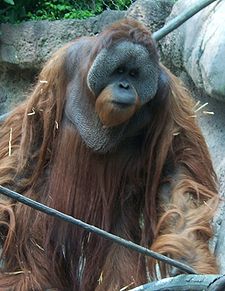
April 12, 2009
Hidden pockets of great apes still exist in the wild around the globe.

A previously undiscovered population of several hundred orangutans was found recently on Sumatra, home to around 7,000 of the Asian apes. The Sumatran orangutan – shown above – (Pongo abelii) is the rarer of the two species of orangutans.

Today comes word that another new population of orangutans has been discovered in that same corner of the world. The find is of Bornean orangutans – shown above – (Pongo pygmaeus), a species of orangutan, as the name implies, native to the island of Borneo.
Perhaps finding Orang Pendek (below) on Sumatra or Borneo might not be far behind?

The Associated Press is spreading the news on Easter Sunday, April 12, 2009:
Conservationists have discovered a new population of orangutans in a remote, mountainous corner of Indonesia — perhaps as many as 2,000 — giving a rare boost to one of the world’s most endangered great apes.
A team surveying forests nestled between jagged, limestone cliffs on the eastern edge of Borneo island counted 219 orangutan nests, indicating a “substantial” number of the animals, said Erik Meijaard, a senior ecologist at the U.S.-based The Nature Conservancy.
“We can’t say for sure how many,” he said, but even the most cautious estimate would indicate “several hundred at least, maybe 1,000 or 2,000 even.”
The team also encountered an adult male, which angrily threw branches as they tried to take photos, and a mother and child.
There are an estimated 50,000 to 60,000 orangutans left in the wild, 90 percent of them in Indonesia and the rest in neighboring Malaysia.
The countries are the world’s top producers of palm oil, used in food, cosmetics and to meet growing demands for “clean-burning” fuels in the U.S. and Europe. Rain forests, where the solitary animals spend almost all of their time, have been clear-cut and burned at alarming rates to make way for lucrative palm oil plantations.
The steep topography, poor soil and general inaccessibility of the rugged limestone mountains appear to have shielded the area from development, at least for now, said Meijaard. Its trees include those highly sought after for commercial timber.
Birute Mary Galdikas, a Canadian scientist who has spent nearly four decades studying orangutans in the wild, said most of the remaining populations are small and scattered, which make them especially vulnerable to extinction.
“So yes, finding a population that science did not know about is significant, especially one of this size,” she said, noting that those found on the eastern part of the island represent a rare subspecies, the black Borneon orangutan, or Pongo pygmaeus morio.
The 700-square mile (2,500-square kilometer) jungle escaped the massive fires that devastated almost all of the surrounding forests in the late 1990s. The blazes were set by plantation owners and small-scale farmers and exacerbated by the El Nino droughts.
Nardiyono, who headed The Nature Conservancy’s weeklong survey in December [2008], said “it could be the density is very high because after the fires, the orangutans all flocked to one small area.”
Read the rest of the AP article here.
++++++++
Hope everyone had a Happy Easter, worshipful Passover, or other observation of this time of year, and are enjoying your spring cleaning.
Thank you for your continued support for the museum and the research that allows my time to be devoted to informing you of the latest news. Much appreciation to those handful of folks who have taken time in the last few days to
About Loren Coleman
Loren Coleman is one of the world’s leading cryptozoologists, some say “the” leading living cryptozoologist. Certainly, he is acknowledged as the current living American researcher and writer who has most popularized cryptozoology in the late 20th and early 21st centuries.
Starting his fieldwork and investigations in 1960, after traveling and trekking extensively in pursuit of cryptozoological mysteries, Coleman began writing to share his experiences in 1969. An honorary member of Ivan T. Sanderson’s Society for the Investigation of the Unexplained in the 1970s, Coleman has been bestowed with similar honorary memberships of the North Idaho College Cryptozoology Club in 1983, and in subsequent years, that of the British Columbia Scientific Cryptozoology Club, CryptoSafari International, and other international organizations. He was also a Life Member and Benefactor of the International Society of Cryptozoology (now-defunct).
Loren Coleman’s daily blog, as a member of the Cryptomundo Team, served as an ongoing avenue of communication for the ever-growing body of cryptozoo news from 2005 through 2013. He returned as an infrequent contributor beginning Halloween week of 2015.
Coleman is the founder in 2003, and current director of the International Cryptozoology Museum in Portland, Maine.
Filed under Breaking News, Cryptotourism, CryptoZoo News, Orang Pendek